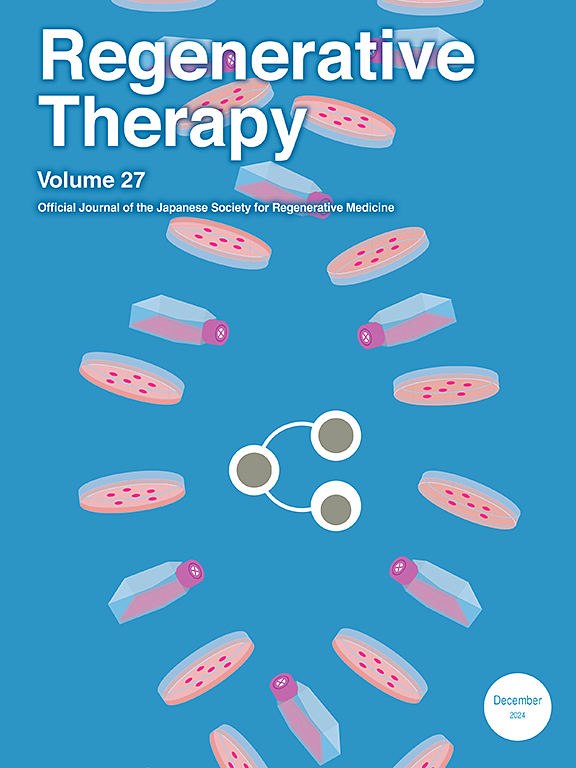培养潜力:用于造血细胞再生治疗的体外细胞培养系统的进展
IF 3.5
3区 环境科学与生态学
Q3 CELL & TISSUE ENGINEERING
引用次数: 0
摘要
干细胞衍生疗法是再生医学领域的重要支柱,利用干细胞自我更新和多能或多能分化能力来产生功能性、特化的细胞来修复和恢复组织功能。造血细胞疗法对再生医学领域的发展至关重要,并且由于最近细胞培养方法的技术创新扩大了其治疗潜力,造血细胞疗法继续保持着重大的希望。新的细胞培养方案的发展,使造血干细胞(HSC)的标准化体外扩增,促进了脐带血同种异体HSC移植的探索。造血干细胞、胚胎干细胞和诱导多能干细胞的定向分化方案,以不依赖供体的方式选择性地产生所需的造血细胞类型,扩大了基于造血细胞的再生治疗的范围。此外,基因组修饰或基因编辑与这些方案的整合已经允许纠正性自体HSC移植,以及赋予造血细胞增强或新的治疗功能的能力。尽管如此,实现大规模临床翻译仍然具有挑战性。目前的努力旨在向化学定义的培养系统迈进,提高谱系特异性分化的效率和可重复性,重点是与基因组修饰和基因编辑协议的兼容性,以便大规模生产高质量、有效和安全的细胞疗法。在这篇综述中,我们总结了该领域的关键里程碑和技术进步,以及有待解决的悬而未决的问题。本文章由计算机程序翻译,如有差异,请以英文原文为准。
Culturing Potential: advances in ex vivo cell culture systems for haematopoietic cell-based regenerative therapies
Stem-cell derived therapies are an essential pillar in the field of regenerative medicine, utilising stem cell self-renewal and multipotent or pluripotent differentiation capabilities to give rise to functional, specialised cells to repair and restore tissue function. Haematopoietic cell therapies have been pivotal to the development of the regenerative medicine field and continue to hold significant promise enabled by recent technical innovation in cell culture approaches that have expanded their therapeutic potential. The development of novel cell culture protocols that allow for the standardised ex vivo expansion of haematopoietic stem cells (HSCs) has facilitated the exploration of umbilical cord blood allogeneic HSC transplantation. Directed differentiation protocols of HSCs, embryonic stem cells and induced pluripotent stem cells, to selectively produce a desired haematopoietic cell type in a donor-independent manner, has broadened the scope for haematopoietic cell-based regenerative therapy. Furthermore, the integration of genome modification or gene editing with these protocols have allowed for corrective autologous HSC transplantation as well as the ability to confer haematopoietic cells with enhanced or novel therapeutic functions. Despite this, realising large-scale clinical translation remains challenging. Current efforts aim to move towards chemically defined culture systems, improving the efficiency and reproducibility of lineage-specific differentiation with an emphasis on compatibility with genome modification and gene-editing protocols for the scalable production of high-quality, efficacious and safe cellular therapies. In this review, we summarise the key milestones and technical advancements in the field in addition to the outstanding questions to be addressed.
求助全文
通过发布文献求助,成功后即可免费获取论文全文。
去求助
来源期刊

Regenerative Therapy
Engineering-Biomedical Engineering
CiteScore
6.00
自引率
2.30%
发文量
106
审稿时长
49 days
期刊介绍:
Regenerative Therapy is the official peer-reviewed online journal of the Japanese Society for Regenerative Medicine.
Regenerative Therapy is a multidisciplinary journal that publishes original articles and reviews of basic research, clinical translation, industrial development, and regulatory issues focusing on stem cell biology, tissue engineering, and regenerative medicine.
 求助内容:
求助内容: 应助结果提醒方式:
应助结果提醒方式:


